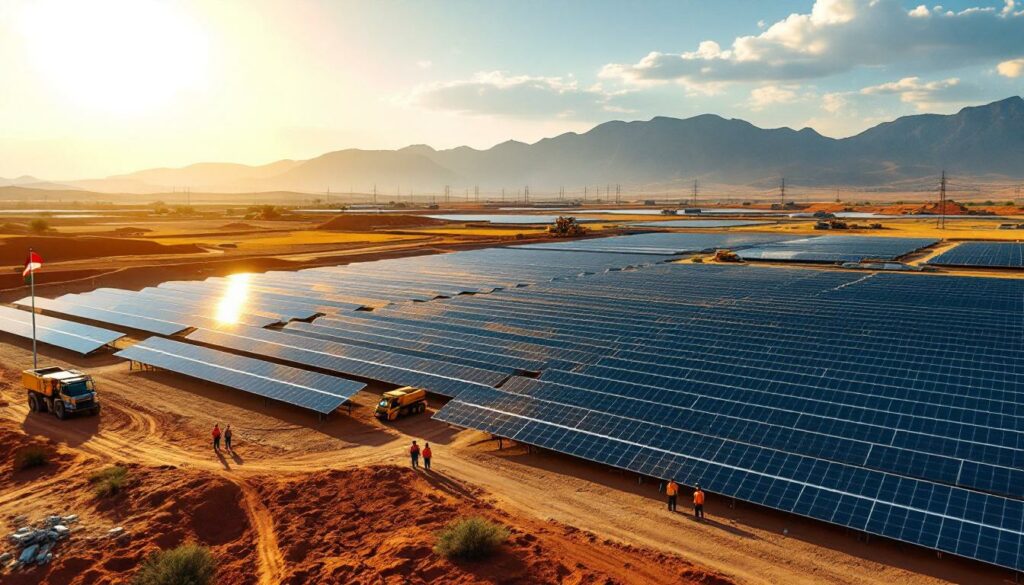The Significance of Zambia's Largest Solar Project
Zambia has taken a decisive step toward energy diversification with the inauguration of the 100MW Chisamba solar plant, marking a watershed moment in the country's renewable energy journey. President Hakainde Hichilema officially launched the facility on June 30, 2025, underscoring its strategic importance amid an ongoing energy crisis that has plagued the nation.
"The drought highlighted the need to urgently diversify the power mix," President Hichilema emphasized during the inauguration ceremony, acknowledging the vulnerability of Zambia's hydropower-dependent infrastructure.
This groundbreaking renewable energy initiative represents the country's largest grid-connected solar power facility to date, significantly outscaling previous projects like the 60MW Bangweulu Solar Plant. The timing couldn't be more critical, as severe drought conditions have dramatically reduced water levels in key reservoirs across Zambia, crippling the nation's hydroelectric generation capacity.
The project exemplifies international collaboration in African renewable energy transformations, with construction led by PowerChina, a global leader in energy infrastructure development with extensive experience across Africa and Asia. This partnership demonstrates growing international confidence in Zambia's renewable energy potential.
"This project represents not just an energy solution, but a model for sustainable development that balances economic growth with environmental responsibility," noted the Minister of Energy during the commissioning ceremony.
The strategic location in Chisamba, within Central Province, was selected for its exceptional solar irradiance metrics and proximity to both transmission infrastructure and First Quantum Minerals' operations—creating a perfect nexus of generation capacity and consumption demand.
What Energy Challenges Does Zambia Face?
Zambia's energy landscape has long been dominated by hydropower, which accounts for approximately 85% of the country's electricity generation capacity. This heavy dependence has created a precarious energy security situation, particularly as climate change impacts intensify across Southern Africa.
The current drought, among the most severe in decades, has drastically reduced water levels in critical reservoirs including the Kariba Dam, which supplies a significant portion of Zambia's electricity. The resulting power deficit has forced state utility Zesco to implement nationwide electricity rationing, with rolling blackouts sometimes extending 12+ hours in both urban and rural areas.
These energy shortages have had cascading effects across Zambia's economy:
- Industrial production disruption: Manufacturing facilities operating at reduced capacity
- Agricultural challenges: Irrigation systems compromised during critical growing seasons
- Healthcare impacts: Medical facilities relying on backup generators at significant cost
- Mining sector vulnerability: Operations at copper mines facing production constraints
To compensate for the shortfall, Zambia has increasingly relied on expensive electricity imports from neighboring countries, primarily South Africa and Mozambique. These imports strain foreign currency reserves and increase production costs across all sectors.
"Low water levels because of a severe drought have forced state utility Zesco to ration electricity," reported Reuters, highlighting the immediate catalyst for accelerating renewable energy development.
The mining sector, which accounts for approximately 70% of Zambia's export earnings, has been particularly vulnerable to these energy challenges. Power interruptions force mines to rely on costly diesel generators or reduce operations, directly impacting production outputs, employment stability, and government tax revenues.
How Will First Quantum Minerals Benefit?
First Quantum Minerals (FQM), one of Africa's largest copper producers, stands to gain significant operational advantages from the Chisamba solar plant. The dedicated 100MW power supply provides a reliable electricity source specifically tailored for FQM's energy-intensive mining operations, creating a buffer against the unpredictable national grid.
This strategic energy partnership delivers multiple benefits to FQM's Zambian operations:
-
Operational stability: The dedicated power supply significantly reduces vulnerability to the rolling blackouts and load shedding that have plagued Zambia's grid, allowing for more consistent mining and processing operations.
-
Production reliability: With steady power availability, FQM can maintain optimal production levels at its Kansanshi and Enterprise mines, avoiding the costly stops and starts that strain equipment and reduce efficiency.
-
Cost predictability: The solar facility provides long-term protection against rising electricity costs and import tariffs, stabilizing one of the most significant operational expenses in mining.
-
ESG enhancement: The shift toward renewable energy transformations substantially reduces FQM's carbon footprint, strengthening the company's environmental credentials with investors, customers, and regulators increasingly focused on sustainability metrics.
-
Competitive advantage: While competitors continue struggling with energy constraints, FQM's dedicated renewable energy supply creates a distinct operational edge in production reliability and cost structure.
For a company that consumed approximately 1.4 million MWh of electricity across its Zambian operations in 2023, the addition of 100MW of solar capacity (potentially generating around 175,000 MWh annually) represents a significant step toward energy independence and sustainability.
This arrangement also creates a reciprocal benefit—while FQM gains energy security, the national grid benefits from reduced demand pressure, effectively freeing up capacity that would otherwise be directed to mining operations.
Technical Specifications of the Chisamba Solar Project
The Chisamba Solar Project employs cutting-edge photovoltaic technology to maximize energy capture in Zambia's high-irradiance environment. With 100 megawatts of generation capacity spread across approximately 250 hectares, the facility ranks among Africa's most significant dedicated mining solar installations.
Key technical elements include:
| Component | Specification |
|---|---|
| Solar capacity | 100 megawatts |
| Panel technology | High-efficiency bifacial modules |
| Inverter systems | Grid-forming smart inverters |
| Land utilization | ~250 hectares |
| Grid connection | 132kV transmission infrastructure |
| Annual generation | ~175,000 MWh (estimated) |
| Developer | PowerChina |
The facility utilizes a sophisticated tracking system that follows the sun's path, optimizing energy capture throughout the day and increasing overall system efficiency by up to 20% compared to fixed installations. This maximizes power production during peak mining operational hours.
PowerChina, the project developer, brings significant experience in renewable energy infrastructure, having constructed similar facilities across multiple continents. Their engineering expertise ensured the plant was completed on schedule despite logistical challenges.
The project's location in Chisamba was selected after extensive feasibility studies, with the region offering:
- Exceptional solar irradiance metrics (averaging 5.5-6.0 kWh/m²/day)
- Proximity to existing transmission infrastructure
- Suitable topography with minimal environmental impact
- Strategic positioning relative to FQM's operations
Perhaps most significantly, the facility was designed with expansion in mind. The transmission infrastructure and substation have been engineered to accommodate the planned additional 100MW capacity, significantly reducing the time and cost required for future expansion.
What Are the National Benefits for Zambia?
The Chisamba solar project delivers multiple strategic advantages for Zambia beyond its immediate energy contribution, creating ripple effects throughout the national economy and energy ecosystem.
Most immediately, the plant directly reduces Zambia's dependency on electricity imports from neighboring countries like South Africa and Mozambique. These imports have placed significant pressure on foreign currency reserves and increased vulnerability to regional pricing fluctuations and supply constraints.
The project provides substantial grid relief by freeing up capacity for domestic consumers that would otherwise be allocated to mining operations. As stated in the PV Magazine report, the facility will "free up capacity for Zambian consumers that would have been used by FQM," effectively creating a dual benefit from a single investment.
From an energy diversification perspective, the 100MW solar facility represents a crucial step toward a more balanced national energy portfolio. By reducing the country's overwhelming 85% dependence on hydropower, Zambia gains critical resilience against climate variability.
"This project demonstrates our commitment to building a diverse energy mix that can withstand climate challenges while supporting economic development," noted a senior Zesco representative at the inauguration.
The economic benefits extend beyond the energy sector:
- Foreign direct investment: The successful implementation demonstrates Zambia's ability to facilitate large-scale international infrastructure projects
- Technology transfer: Local engineers and technicians gained valuable experience in cutting-edge renewable technologies
- Job creation: The project employed over 500 workers during construction and maintains approximately 50 permanent positions
- Rural development: Infrastructure improvements in the Chisamba region benefit agricultural and community activities beyond the energy project
Perhaps most significantly, the project establishes Zambia as a leader in mining industry innovation, potentially attracting additional investment in both mining and energy infrastructure.
Future Expansion and Renewable Energy Plans
The Chisamba solar facility represents just the beginning of Zambia's renewable energy transformation. Plans are already underway to double the current capacity with an additional 100MW expansion at the same site, though specific timelines remain under development pending regulatory approvals and financing arrangements.
This expansion aligns with Zambia's broader energy transition and security strategy, which targets increasing renewable energy's contribution to the national mix from approximately 15% to 30% by 2030 (excluding large hydropower).
For First Quantum Minerals, the Chisamba project forms part of a comprehensive energy security strategy. While specific details of additional projects remain confidential, industry sources indicate the company is exploring:
- Wind energy potential: Feasibility studies for wind farms in Zambia's Northern Province
- Battery storage integration: Advanced energy storage systems to maximize renewable utilization
- Energy efficiency initiatives: Comprehensive audits and retrofits across mining operations
- Microgrid development: Localized generation and distribution networks at remote operations
These initiatives position FQM at the forefront of electrification in mining, potentially establishing models for other operators facing similar challenges.
Nationally, Zambia's renewable energy roadmap includes:
- Streamlined regulations: Accelerated approval processes for renewable projects
- Incentive structures: Tax benefits for renewable investments
- Skills development: Training programs for renewable technology maintenance
- Grid modernization: Smart infrastructure to accommodate variable renewable inputs
This coordinated approach positions Zambia as a potential renewable energy leader in Southern Africa, leveraging its abundant solar resources to address immediate energy challenges while building long-term resilience.
How Does This Project Compare to Other Mining-Focused Renewable Initiatives?
The Chisamba solar project stands out in scale and approach when compared to other mining-focused renewable energy initiatives across Africa and globally. With its 100MW capacity dedicated primarily to mining operations while maintaining grid connection, it represents one of the continent's most ambitious mining-energy partnerships.
In comparative context:
| Project | Location | Capacity | Mining Partner | Grid Connection |
|---|---|---|---|---|
| Chisamba Solar | Zambia | 100MW | First Quantum | Yes |
| DeGrussa Solar | Australia | 10.6MW | Sandfire Resources | Hybrid system |
| Bisha Mine Solar | Eritrea | 7.5MW | Nevsun Resources | Off-grid |
| Essakane Solar | Burkina Faso | 15MW | IAMGOLD | Hybrid system |
| Otjikoto Solar | Namibia | 5MW | B2Gold | Off-grid |
What distinguishes the Chisamba project is its public-private partnership model, combining government policy support, utility integration, and private mining investment. This collaborative approach creates benefits beyond the immediate mining operation, supporting national energy objectives while meeting corporate needs.
The project's replicability potential is significant. Its financing structure, technical implementation, and operational model provide a template for other mining operations across the continent facing similar energy security challenges. Several copper producers in the Democratic Republic of Congo and nickel miners in Tanzania are reportedly studying the Chisamba model for potential adaptation.
"The Chisamba project demonstrates how mining companies can be part of the energy solution rather than just energy consumers," noted a regional energy analyst familiar with the project.
The integration approach—supplying mining operations while connected to the national grid—represents a particularly innovative aspect. Unlike many mining renewable projects that function as isolated islands, Chisamba's grid connection creates flexibility that benefits both the mining operation and the broader community.
Economic Implications for Zambia's Copper Sector
The establishment of the Chisamba solar plant creates far-reaching economic implications for Zambia's critical copper sector, which accounts for approximately 70% of the country's export earnings and 12% of GDP. Enhanced energy security directly strengthens the industry's resilience and competitiveness in global markets.
Production stability represents the most immediate benefit. Copper mining and processing require consistent, reliable power at multiple stages:
- Extraction operations (drilling, blasting, hauling)
- Crushing and grinding processes
- Concentration through flotation
- Smelting and refining
- Water management and tailings processing
Interruptions at any stage create bottlenecks that ripple throughout the production chain. By ensuring reliable power for First Quantum's operations, the Chisamba project helps maintain production continuity, protecting both output volumes and product quality.
This enhanced reliability sends positive investment signals to international mining investors evaluating Zambia's attractiveness for capital deployment. As one mining sector analyst noted, "Energy security ranks among the top three considerations for mining investment decisions in sub-Saharan Africa."
The export potential implications are substantial. With copper prices experiencing strong demand driven by global electrification and decarbonisation trends, Zambia's ability to maintain consistent production volumes positions the country to capitalize on favorable market conditions. Each day of uninterrupted production represents approximately $15-20 million in export value.
Job security benefits extend beyond direct mining employment. First Quantum directly employs over 8,500 people in Zambia, with tens of thousands more jobs in supporting industries dependent on mining activity. Energy instability threatened these positions; the solar project helps protect this employment ecosystem.
For government revenues, stable mining operations translate to predictable tax streams. Mining royalties, corporate taxes, and PAYE contributions from the sector collectively represent approximately 30% of Zambia's tax base—revenue that funds critical social services and infrastructure development.
FAQ: Zambia's Solar Energy and Mining Connection
What makes the Chisamba solar plant significant for Zambia?
The 100MW Chisamba facility represents Zambia's largest grid-connected solar plant and a critical step in diversifying the country's energy mix beyond hydropower. Its timing during severe drought conditions provides immediate relief to the stressed national grid while supporting the vital copper mining industry. The project demonstrates how renewable energy can address both immediate crisis needs and long-term sustainability goals simultaneously.
How will this solar project impact Zambia's electricity imports?
By supplying First Quantum Minerals directly, the plant frees up approximately 100MW of national grid capacity that would otherwise be used by the mining company. This reduction decreases Zambia's need to import electricity from South Africa and Mozambique, conserving foreign currency reserves and reducing exposure to regional energy market volatility. Estimates suggest the project could reduce electricity imports by approximately 175,000 MWh annually.
What are First Quantum Minerals' broader renewable energy plans?
While specific details remain confidential, industry sources indicate First Quantum is exploring additional solar capacity expansion at Chisamba and evaluating wind energy potential in Zambia's Northern Province. The company is also investigating energy storage solutions to maximize renewable utilization and developing comprehensive energy efficiency initiatives across its operations. These efforts align with FQM's global commitment to reducing carbon intensity while enhancing operational reliability.
When will the planned 100MW expansion at Chisamba be completed?
No specific timeframe has been established for the additional 100MW capacity at the Chisamba site. The expansion requires coordination between multiple stakeholders including PowerChina, First Quantum Minerals, Zesco, and regulatory authorities. Factors affecting the timeline include financing arrangements, equipment procurement, and integration planning with the existing facility. Industry observers anticipate more definitive announcements regarding expansion timelines by late 2025.
How does this project address Zambia's current energy crisis?
The solar plant provides immediate relief by adding 100MW of drought-resistant generation capacity to Zambia's strained energy system. This solar contribution, unlike hydropower, remains consistent regardless of rainfall patterns, providing a reliable baseload during daylight hours. By supplying First Quantum directly, the project also reduces pressure on the national grid, effectively creating additional capacity for domestic and commercial consumers without requiring new generation assets for those segments.
Ready to Stay Ahead of Major Mineral Discoveries?
Discover how significant ASX mineral announcements can lead to transformative investment returns by exploring Discovery Alert's dedicated discoveries page, where our proprietary Discovery IQ model turns complex mineral data into actionable insights for both short-term traders and long-term investors.




